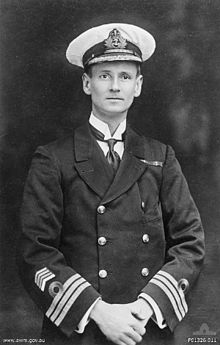| Rear AdmiralSir Leighton BracegirdleKCVO, CMG, DSO | |
|---|---|
 Commander Leighton Bracegirdle c. 1918 Commander Leighton Bracegirdle c. 1918 | |
| 3rd Official Secretary to the Governor-General of Australia | |
| In office 1931–1947 | |
| Monarchs | George V Edward VIII George VI |
| Governors‑General | Sir Isaac Isaacs The Earl of Gowrie The Duke of Gloucester Sir William McKell |
| Preceded by | John Starling |
| Succeeded by | Sir Murray Tyrrell |
| Personal details | |
| Born | (1881-05-31)31 May 1881 Balmain, New South Wales |
| Died | 23 March 1970(1970-03-23) (aged 88) Sydney, New South Wales |
| Nickname | "Brace" |
| Military service | |
| Allegiance | Australia |
| Branch/service | Royal Australian Navy |
| Years of service | 1898–1945 |
| Rank | Rear Admiral |
| Commands | Director of Naval Reserves (1923–31) Royal Australian Navy Bridging Train (1915–17) |
| Battles/wars | |
| Awards | Knight Commander of the Royal Victorian Order Companion of the Order of St Michael and St George Distinguished Service Order Mentioned in Despatches (3) |
Rear Admiral Sir Leighton Seymour Bracegirdle, KCVO, CMG, DSO (31 May 1881 – 23 March 1970) was an Australian naval officer and an Official Secretary to four Australian governors-general: Sir Isaac Isaacs, Lord Gowrie, the Duke of Gloucester, and William McKell.
Early life
Leighton Seymour Bracegirdle was born in Balmain, Sydney, on 31 May 1881. He attended Sydney Boys High School, in 1898 he joined the New South Wales Naval Brigade as a cadet. Two years later he became a midshipman and served with the New South Wales contingent in China during the Boxer Rebellion.
Bracegirdle then served as a lieutenant in the South African Irregular Horse in the final year of the Boer War. He returned to Australia after being wounded and continued to serve in the naval militia while working as a clerk. He married Lillian Saunders in 1910 and in 1911 joined the Royal Australian Navy as a lieutenant, serving as District Officer in Newcastle until the beginning of the First World War.
First World War
| This section does not cite any sources. Please help improve this section by adding citations to reliable sources. Unsourced material may be challenged and removed. (November 2024) (Learn how and when to remove this message) |
In August 1914, Bracegirdle enlisted in the Australian Naval and Military Expeditionary Force, serving as a staff officer in German New Guinea until the force was disbanded in February 1915. That month he was appointed commander of the 1st Royal Australian Naval Bridging Train and was sent to Gallipoli to prepare for the British landings at Suvla Bay in August 1915. His unit performed well under relentless shrapnel fire and remained at Suvla, where Bracegirdle was wounded, until the end of the campaign. Having constructed the piers used during the British landing, the bridging train carried out maintenance duties; assisted with the landing of troops, stores, and ammunition; and finally assisted with the evacuation in December.
After a period in hospital suffering from jaundice and malaria, Bracegirdle returned to his unit, which was now working on the Suez Canal. Bracegirdle was awarded the Distinguished Service Order in June 1916 and received his third Mention in Despatches in July of that year. The bridging train remained in the Middle East, assisting with the Allied advance across the Sinai by landing stores on the Mediterranean coast, but was disbanded at the beginning of 1917. Bracegirdle's command ended in March and he returned to Australia having been promoted to commander.
Post-war and Official Secretary
Between 1918 and 1921, Bracegirdle was a District Naval Officer in Adelaide. This was followed by a similar posting in Sydney, which he held until 1923, when he was appointed Director of Naval Reserves. In 1924 he received another promotion, to captain.
Bracegirdle was appointed Military and Official Secretary to the Governor-General in 1931. His posting spanned the tenure of three governors-general (Sir Isaac Isaacs, Lord Gowrie, and the Duke of Gloucester).
After a couple of extensions his retirement was overdue, and he planned to retire when the Duke of Gloucester returned to Britain in mid-January 1947. He remained at his post, however, to assist the Administrator of the Commonwealth Sir Winston Dugan while a replacement Official Secretary was found. (The post was offered to two other serving officers, who both declined because the salary was too low.) Shortly after William McKell became Governor-General, Murray Tyrrell accepted the position in March 1947. Bracegirdle retired from the Navy having attained the rank of rear admiral. After his retirement, he worked for BHP and held directorships in several other companies. He died on 23 March 1970 in Sydney.
References
- http://www.shsobu.org.au/wp-content/uploads/imperial-honours.pdf ORDER OF THE BRITISH EMPIRE at the Wayback Machine (archived 23 March 2019)
- Navy, corporateName=Royal Australian. "Rear Admiral Leighton Seymour Bracegirdle". www.navy.gov.au. Retrieved 10 April 2020.
- Christopher Cunneen: William John McKell
External links
| Government offices | ||
|---|---|---|
| VacantTitle last held byJohn Starling in 1927 | Official Secretary to the Governor-General of Australia 1931–1947 |
Succeeded bySir Murray Tyrrell |
- 1881 births
- 1970 deaths
- Australian Companions of the Distinguished Service Order
- Australian Companions of the Order of St Michael and St George
- Australian Knights Commander of the Royal Victorian Order
- Australian military personnel of the Second Boer War
- Australian military personnel of World War I
- Military personnel of the Boxer Rebellion
- Royal Australian Navy admirals
- Royal Australian Navy personnel of World War II
- People educated at Sydney Boys High School